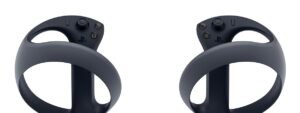
Physical objects like walls and furniture that are experienced in virtual reality could be given a new weight and feel using a device developed by Carnegie Mellon University researchers.
The device uses multiple strings attached to the hand and fingers to simulate the feel of obstacles and heavy objects.
By locking the strings when the user’s hand is near a virtual wall, for instance, the device simulates the sense of touching the wall.
Similarly, the string mechanism enables people to feel the contours of a virtual sculpture; sense resistance when they push on a piece of furniture, or even give a ‘high five’ to a virtual character.
The shoulder-mounted device takes advantage of spring-loaded strings to reduce weight, consume less battery power and keep costs low.
“Elements such as walls, furniture and virtual characters are key to building immersive virtual worlds and yet contemporary VR systems do little more than vibrate hand controllers,” said Chris Harrison, assistant professor in CMU’s Human-Computer Interaction Institute (HCII).
People who used the multistring device found it was more realistic than other haptic techniques.
“I think the experience creates surprises, such as when you interact with a railing and can wrap your fingers around it,” Fang said. “It’s also fun to explore the feel of irregular objects, such as a statue.”
Other researchers have used strings to create haptic feedback in virtual worlds, but typically they use motors to control the strings. Motors wouldn’t work for the CMU researchers, who envisioned a system both light enough to be worn by the user and affordable for consumers.
“The downside to motors is they consume a lot of power,” Fang said. “They also are heavy.”
Instead of motors, the team used spring-loaded retractors, similar to those seen in key chains or ID badges. They added a ratchet mechanism that can be rapidly locked with an electrically controlled latch.
The springs, not motors, keep the strings taut. Only a small amount of electrical power is needed to engage the latch, so the system is energy efficient and can be operated on battery power.
A number of different strings and string placements were experimented with. The conclusion was that attaching one string to each fingertip, one to the palm, and one to the wrist provided the best experience.
A Leap Motion sensor, which tracks hand and finger motions, is attached to the VR headset. When it senses that a user’s hand is in proximity to a virtual wall or other obstacle, the ratchets are engaged in a sequence suited to those virtual objects. The latches disengage when the person withdraws their hand.
The entire device weighs less than 300g and the researchers estimate that a mass-produced version would cost less than $50 (£40).
Sign up to the E&T News e-mail to get great stories like this delivered to your inbox every day.
- ADvantage
- around
- Assistant
- badges
- battery
- BEST
- Building
- Carnegie Mellon
- Carnegie mellon university
- CMU
- consume
- Consumers
- content
- Costs
- day
- energy
- For Consumers
- fun
- great
- Headset
- High
- HTTPS
- immersive
- interaction
- IT
- Key
- leap motion
- light
- mass-produced
- Near
- news
- Other
- People
- power
- Reality
- reduce
- sense
- small
- So
- Stories
- system
- Systems
- university
- Virtual
- Virtual reality
- vr
- VR Headset
- weighs
- WHO
- Work
- youtube








